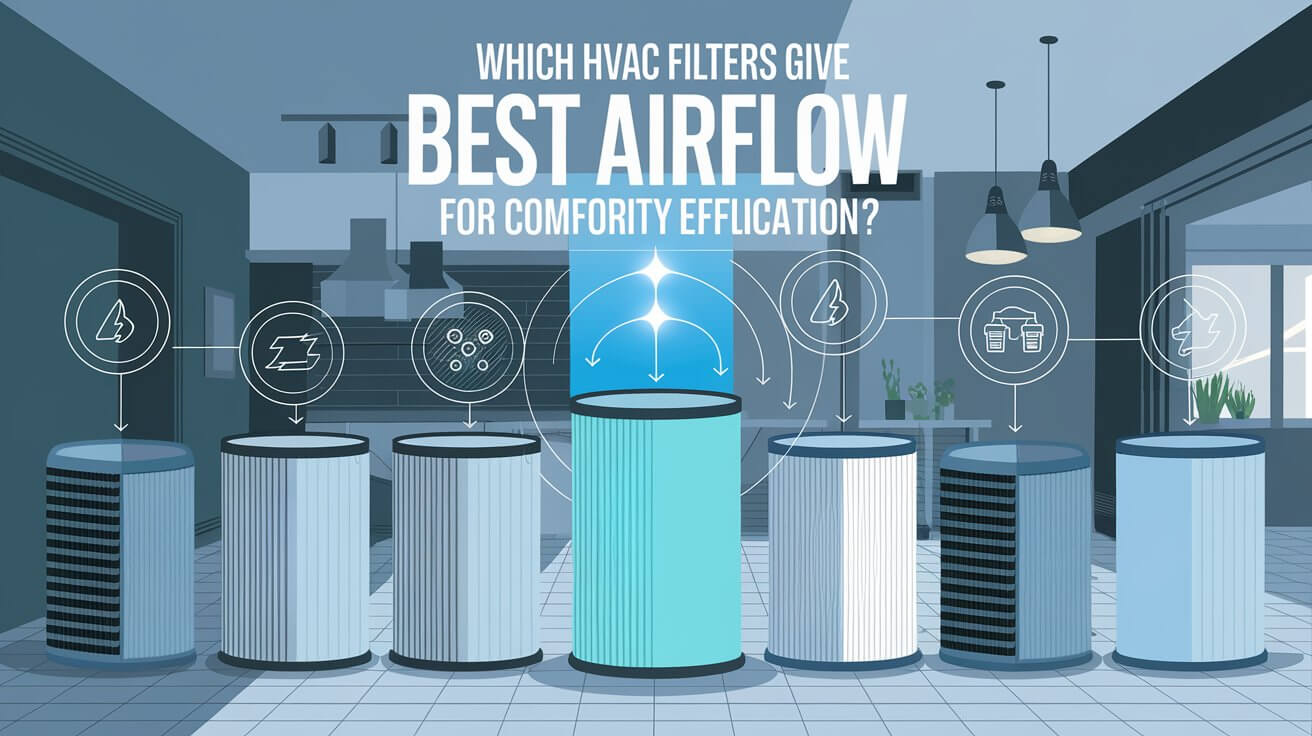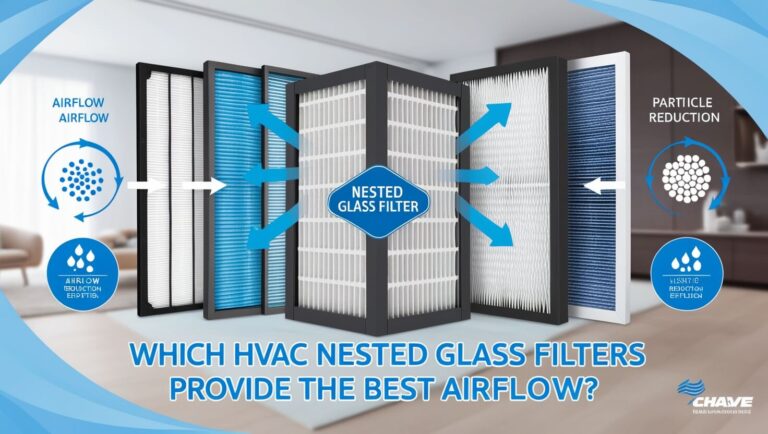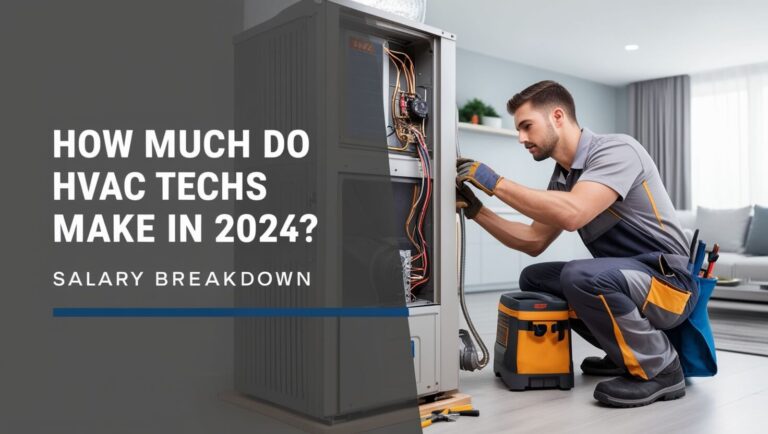Which HVAC Filters Give Best Airflow for Optimal Efficiency

Choosing the right HVAC filter is critical for maintaining optimal airflow and indoor air quality. However, not all filters are created equal. Some offer excellent filtration but can limit airflow, while others strike a balance between the two. In this comprehensive guide, we’ll break down which HVAC filters give the best airflow, factors that affect airflow, and how to choose the right filter for your home or business.
What Factors Affect HVAC Airflow?
Before diving into the specifics of filter types, it’s essential to understand what factors affect airflow in an HVAC system. Filters are a major component, but other factors can also impact the performance of your system.
Filter Material and Type
Different filter materials affect airflow in various ways. While pleated filters are designed to trap more particles, they can restrict airflow more than non-pleated options. The material used, such as fiberglass or polyester, will determine how much air can pass through.
Filter Size
Filters come in various sizes, and the surface area of the filter can affect both airflow and filtration efficiency. A larger filter surface allows for more air to pass through while still capturing airborne particles.
MERV Rating
The Minimum Efficiency Reporting Value (MERV) is a rating that reflects how well a filter captures particles of varying sizes. A higher MERV rating means better filtration but can also restrict airflow more.
HVAC System Size and Age
Older systems or those that aren’t sized correctly for the building can experience reduced airflow regardless of the filter used. Keeping your system in good condition and using the right filter for your system’s design can help maintain better airflow.
The Best HVAC Filters for Optimal Airflow
Finding a balance between filtration and airflow is key. High MERV filters may offer superior filtration, but they can strain your system if not properly selected. Here’s a breakdown of the best filters that provide optimal airflow without sacrificing air quality.
Pleated vs. Non-Pleated Filters
Pleated and non-pleated filters offer different advantages and disadvantages when it comes to airflow.
Pleated Filters
Pleated filters are designed with folds that increase the surface area available for capturing particles. This makes them more efficient at filtering out contaminants but also means they can restrict airflow more than non-pleated filters.
- Pros: Better filtration, longer lifespan, captures smaller particles.
- Cons: Can restrict airflow, higher cost.
Non-Pleated Filters
Non-pleated filters, usually made from fiberglass, allow more air to pass through but don’t capture as many particles. They are typically more affordable and easier for air to pass through, making them a good choice if maximizing airflow is your main concern.
- Pros: Excellent airflow, low cost, easy to replace.
- Cons: Less effective at capturing fine particles, shorter lifespan.
MERV Ratings and Their Impact on Airflow
The MERV rating of a filter measures its ability to capture particles. Higher ratings provide better filtration but can decrease airflow.
Low MERV Filters (1-4)
These filters capture large particles like dust and lint but offer minimal resistance to airflow. They are perfect if your priority is maximizing airflow, but they won’t capture smaller airborne contaminants.
- Best for: Situations where airflow is the priority and the air quality demands are lower.
- Airflow: Excellent.
Medium MERV Filters (5-8)
This range is considered a good balance for most homes. Filters with MERV ratings between 5 and 8 capture pollen, mold spores, and pet dander without significantly reducing airflow.
- Best for: Homes with pets, light to moderate allergies, and typical air quality needs.
- Airflow: Good to moderate.
High MERV Filters (9-12)
These filters can capture much smaller particles, including some bacteria and smoke, but can significantly reduce airflow if the system is not designed for them. For most residential HVAC systems, filters in this range may cause airflow issues.
- Best for: High air quality needs, homes with severe allergies, or medical conditions.
- Airflow: Restricted, but manageable for some systems.
Very High MERV Filters (13-16)
Filters in this range are used in hospitals and cleanrooms where air quality is paramount. However, using such filters in residential systems can drastically reduce airflow and may even damage your HVAC system if it is not built to handle the added strain.
- Best for: Specialized commercial use or medical settings.
- Airflow: Severely restricted.
HEPA Filters: Good for Air Quality, Bad for Airflow?
HEPA (High-Efficiency Particulate Air) filters are often considered the gold standard in filtration, capturing up to 99.97% of particles down to 0.3 microns. However, these filters are not recommended for most residential HVAC systems.
Pros and Cons of HEPA Filters
- Pros: Unmatched filtration, captures microscopic particles, used in hospitals and labs.
- Cons: Extremely restrictive, not suitable for most HVAC systems, can severely reduce airflow.
For residential use, HEPA filters can cause airflow issues unless your HVAC system is specifically designed to handle them. Using a HEPA filter in a standard system can lead to equipment failure due to the added strain.
How to Choose the Right HVAC Filter for Airflow
Now that we’ve covered the types of filters and their impact on airflow, here are some tips on how to choose the right filter for your needs.
1. Consider Your Air Quality Needs
If you don’t have severe allergies or medical conditions, a filter with a lower MERV rating (between 5 and 8) should be sufficient. This will provide a good balance of filtration and airflow.
2. Match the Filter to Your HVAC System’s Capacity
Check your HVAC system’s specifications to ensure it can handle the filter you plan to use. Most residential systems are not built to handle high-MERV or HEPA filters, so sticking to a filter with a MERV rating between 5 and 8 is often ideal.
3. Replace Your Filter Regularly
Even the best filters need to be replaced regularly. A dirty or clogged filter can restrict airflow even if it was initially designed for good airflow. As a rule of thumb, replace your filter every 1-3 months depending on usage and air quality conditions.
4. Consider System Maintenance
Proper maintenance of your HVAC system will improve airflow and overall efficiency. Clean your ducts, check for leaks, and ensure that your system is operating at its best.
Balancing Air Quality and Airflow: What Works Best?
Achieving the best balance between air quality and airflow requires careful consideration of your home’s needs, the capabilities of your HVAC system, and the type of filter you use. Here are some quick recommendations based on common scenarios:
- Homes with Pets: Use a medium MERV filter (5-8) to capture pet dander without compromising airflow.
- Homes with Allergies: Opt for a higher MERV filter (8-12) if air quality is more important than airflow. Just be mindful of potential airflow issues.
- Commercial Buildings: Use a filter with a MERV rating between 9 and 12 to capture contaminants without drastically reducing airflow.
- Medical Settings: HEPA filters are necessary, but ensure the system is designed to accommodate them.
Best HVAC Filters for Airflow: A Detailed Look
Now, let’s review some of the top HVAC filters that provide excellent airflow while still offering good filtration.
Aerostar Pleated Air Filter (MERV 13)
This filter captures a significant amount of airborne particles while maintaining relatively good airflow. It is a good choice for homes that need higher air quality without sacrificing too much airflow.
Filtrete 20x25x1 MERV 12
Known for its balance of airflow and filtration, this filter is a popular choice for homes with moderate allergy concerns. It captures allergens like pet dander and pollen without causing too much strain on the system.
Nordic Pure MERV 12 Pleated Filter
This filter captures a wide range of particles, including dust mites, pollen, and mold spores, making it a solid choice for most residential applications. Its pleated design offers better filtration, but it can still maintain airflow in many systems.
Conclusion
When it comes to selecting an HVAC filter that provides the best airflow, it’s all about finding the right balance. Non-pleated filters with lower MERV ratings (between 5 and 8) are ideal for maximizing airflow while still providing adequate filtration. On the other hand, pleated filters and those with higher MERV ratings (9-12) offer better filtration but can restrict airflow if not carefully chosen. Regardless of the type of filter you select, regular maintenance and timely replacement are crucial to ensuring your HVAC system operates efficiently.
By following these guidelines and considering your home’s specific air quality and system needs, you can select the perfect HVAC filter that ensures both good airflow and clean air in your living space.




